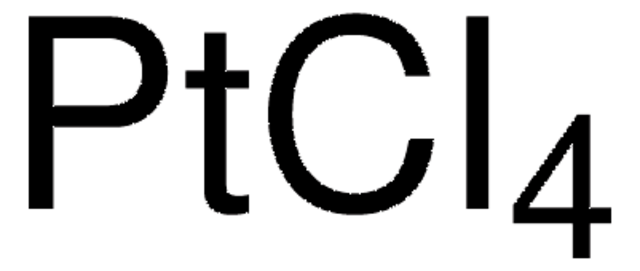Kluczowe dokumenty
206083
Chloroplatinic acid hexahydrate
ACS reagent, ≥37.50% Pt basis
Synonim(y):
Hexachloroplatinic acid hexahydrate, Hydrogen hexachloroplatinate(IV) hexahydrate, Platinic chloride hexahydrate
About This Item
Polecane produkty
klasa czystości
ACS reagent
Poziom jakości
Postać
powder or chunks
przydatność reakcji
reagent type: catalyst
core: platinum
stężenie
≥37.5% Pt
rozpuszczalność
alcohol: soluble
ślady kationów
alkalies and other metals: ≤0.05%
ciąg SMILES
O.O.O.O.O.O.Cl.Cl.Cl[Pt](Cl)(Cl)Cl
InChI
1S/6ClH.6H2O.Pt/h6*1H;6*1H2;/q;;;;;;;;;;;;+4/p-4
Klucz InChI
PIJUVEPNGATXOD-UHFFFAOYSA-J
Szukasz podobnych produktów? Odwiedź Przewodnik dotyczący porównywania produktów
Opis ogólny
Zastosowanie
- Preparation of Pd nanocubes (150nm width) and Pt nanospheres (150nm diameter).
- To compose the plating solution for the electrodeposition of Pt nanoparticles on the multilayered graphene petal nanosheets (MGPNs).
- Synthesis of nano-composites of Pt and nano-carbon (NC).3
Hasło ostrzegawcze
Danger
Zwroty wskazujące rodzaj zagrożenia
Zwroty wskazujące środki ostrożności
Klasyfikacja zagrożeń
Acute Tox. 3 Oral - Eye Dam. 1 - Resp. Sens. 1 - Skin Corr. 1B - Skin Sens. 1
Kod klasy składowania
6.1C - Combustible acute toxic Cat.3 / toxic compounds or compounds which causing chronic effects
Klasa zagrożenia wodnego (WGK)
WGK 1
Temperatura zapłonu (°F)
Not applicable
Temperatura zapłonu (°C)
Not applicable
Certyfikaty analizy (CoA)
Poszukaj Certyfikaty analizy (CoA), wpisując numer partii/serii produktów. Numery serii i partii można znaleźć na etykiecie produktu po słowach „seria” lub „partia”.
Masz już ten produkt?
Dokumenty związane z niedawno zakupionymi produktami zostały zamieszczone w Bibliotece dokumentów.
Klienci oglądali również te produkty
Nasz zespół naukowców ma doświadczenie we wszystkich obszarach badań, w tym w naukach przyrodniczych, materiałoznawstwie, syntezie chemicznej, chromatografii, analityce i wielu innych dziedzinach.
Skontaktuj się z zespołem ds. pomocy technicznej










